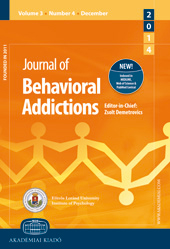Gambling disorder and bilateral transcranial direct current stimulation: A case report
Gambling disorder and bilateral transcranial direct current stimulation: A case report
Author(s): Giovanni Martinotti, Eleonora Chillemi, Matteo LupiSubject(s): Behaviorism
Published by: Akadémiai Kiadó
Keywords: transcranical direct current stimulation; gambling disorder; dorsolateral prefrontal cortex
Summary/Abstract: Gambling disorder (GD) is a major public health concern with currently no validated and efficacious treatments approved. In this single case study, we report the short- and long-term effect of bilateral transcranial direct current stimulation (tDCS) of dorsolateral prefrontal cortex (DLPFC) on craving and impulse control in a subject with GD. Methods. The patient is a 26-year-old Caucasian male with an 8-year history of GD as well as alcohol and cocaine misuse. Treatment consisted of twice-a-day stimulation for 10 days. According to the literature, both the left (to control craving) and the right (to control emotional impulses) DLPFC were stimulated. Patients subsequently received tDCS once a week for 3 months and then once every 2 weeks for another 3 months. Results. After 10 days of treatment, the subject reported improved psychiatric symptoms (depression, anxiety, and impulsivity), as well as reduced gambling craving symptom severity. After 3 and 6 months of treatment, the clinical picture further improved. Discussion. This is the first report of tDCS effectiveness in a single case study of GD. Therapeutic effects, both on the addictive behavior and on psychiatric comorbid symptomatology, were lasting and continued over 6 months of tDCS maintenance treatment. Future case–control studies are required to test the efficacy of this tool in patients with GD.
Journal: Journal of Behavioral Addictions
- Issue Year: 7/2018
- Issue No: 3
- Page Range: 834-837
- Page Count: 4
- Language: English

